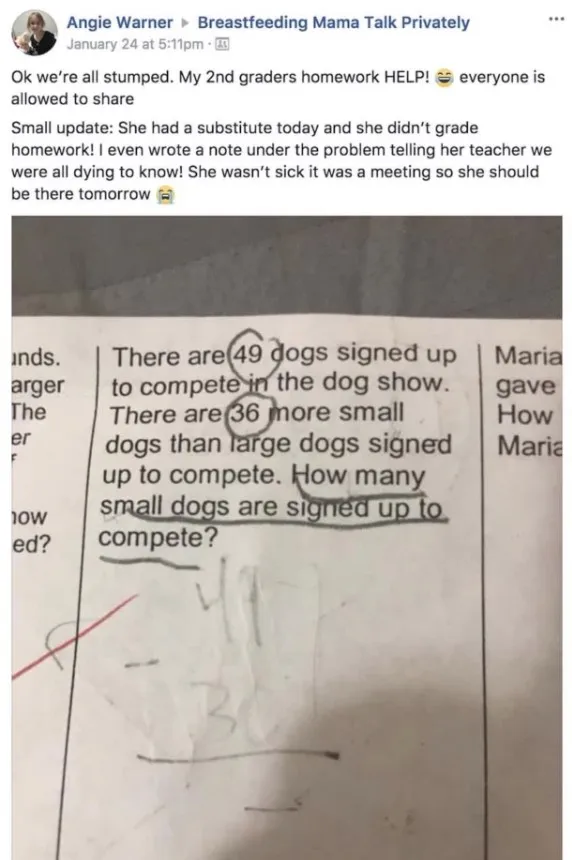A mom shared her 2nd grader’s difficult math homework online, surprising many internet users who found it challenging to solve.
Mom shares 2nd grader’s difficult math homework to find answers from online users
Recently, a mom shared her 2nd grader’s math homework online, and it left many internet users baffled.
The homework, which seemed simple at first glance, turned out to be a real head-scratcher for many adults.

This math problem has sparked a lot of interest and debate about the complexity of modern elementary school homework.
Many people are discussing how to find its answer, even grown-ups also embarked on this event.
The math homework isn’t as easy as people thought
Angie, a mother of a second-grader, shared her child’s math homework online, seeking assistance from fellow parents.
The question, which appeared straightforward at first glance, read:
“There are 49 dogs signed up to compete in the dog show. There are 36 more small dogs than large dogs signed up to compete.
How many small dogs are signed up to compete?”

At first glance, the answer seemed obvious 36 small dogs.
However, as responses poured in from the online community, it became clear that the problem was far more complex than it initially appeared.
Both expert mathematicians and regular parents were confused. They struggled with the tricky wording of the question.

After many discussions, people finally broke the answer.
The solution to the perplexing math problem from Angie’s second-grader’s homework involved a careful application of algebraic principles.
The first step was to let the number of large dogs be represented by the variable ‘x’ and the number of small dogs be represented by the variable ‘y.’
With this setup, the total number of dogs competing in the show was given as 49, so the equation x + y = 49 could be written.

Additionally, the problem stated that there were 36 more small dogs than large dogs, which led to the equation y = x + 36.
The equation x + (x + 36) = 49 was obtained by substituting the second equation into the first.
Solving this equation revealed that the number of large dogs, x, was equal to 6.5, and the number of small dogs, y, was equal to 42.5.
This unusual solution showed the need to use logic and be open to looking beyond the simple answer.

Social media reaction
On social media, people shared their difficulties in solving this math problem.
Many people commented on the post, expressing their surprise and frustration at the difficulty of the question.
Some admitted that they couldn’t solve it, while others shared their attempts and different methods of arriving at the solution.
Simply just 36 small dogs signed up. The rest are large dogs which give a total of 49 dogs (including big and small) signed up, one user gave their answer.
Perhaps the question is deliberately worded poorly to confuse the readers.
The one who posted this question should provide the logical answer in accordance with the text of question, the second user claimed.
The question is simple and straight forward… 36 small dogs is the answer, the third user insisted.
The question should’ve asked how many large dogs signed up, another suggested.
Confusing question, another wrote.